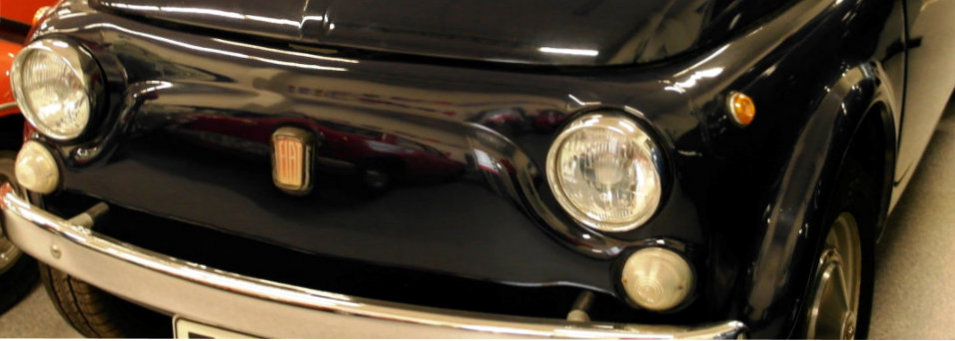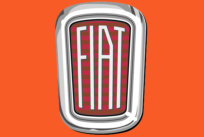
















Over 3.6 million Cinquecento´s manufactured between 1957 and 1975

Fiat 500 - 1969
The Fiat 500 (Italian: Cinquecento) is a city car produced
by the Italian manufacturer Fiat between 1957 and 1975.
Launched as the Nuova (new) 500 in July 1957, it was a cheap and practical town car. Measuring only 2.97 metres (9 feet 9 inches) long, and originally powered by an appropriately
Measuring only 2.97 metres (9 feet 9 inches) long, and originally powered by an appropriately sized 479 cc two-cylinder, air-cooled engine, the 500 redefined the term "small car" and is
sized 479 cc two-cylinder, air-cooled engine, the 500 redefined the term "small car" and is considered one of the first city cars.
In 2007, the 50th anniversary of the Nuova 500's launch, Fiat launched another new 500,
considered one of the first city cars.
In 2007, the 50th anniversary of the Nuova 500's launch, Fiat launched another new 500, stylistically inspired by the 1957 Nuova 500 but considerably heavier and larger, featuring a
stylistically inspired by the 1957 Nuova 500 but considerably heavier and larger, featuring a front-mounted engine and front-wheel drive.
front-mounted engine and front-wheel drive.
History
To meet the demands of the post-war market which called for economy cars, in 1949 a front engine, Fiat 500 was released, a 2-door coupe body with sun-roof, this was later
engine, Fiat 500 was released, a 2-door coupe body with sun-roof, this was later complemented by an Estate (Station Wagon) version; both continued until 1954 before
complemented by an Estate (Station Wagon) version; both continued until 1954 before replaced by the all new, lighter body car with rear-engine, on the pattern of the Volkswagen
replaced by the all new, lighter body car with rear-engine, on the pattern of the Volkswagen Beetle, just like its bigger brother, the 1955 Fiat 600. Several car makers followed the now
Beetle, just like its bigger brother, the 1955 Fiat 600. Several car makers followed the now uncommon rear engine configuration at the time and were quite successful. The Neckar
uncommon rear engine configuration at the time and were quite successful. The Neckar version manufactured in Heilbronn under a complicated deal involving NSU, was introduced
version manufactured in Heilbronn under a complicated deal involving NSU, was introduced in October 1961.[2] In Upper Austria the firm of Steyr-Puch also produced cars based, by
in October 1961.[2] In Upper Austria the firm of Steyr-Puch also produced cars based, by agreement, on the Fiat 500.
agreement, on the Fiat 500. Despite its diminutive size, the 500 proved to be an enormously practical and popular vehicle
Despite its diminutive size, the 500 proved to be an enormously practical and popular vehicle throughout Europe. Besides the two-door coupé, it was also available as the "Giardiniera"
throughout Europe. Besides the two-door coupé, it was also available as the "Giardiniera" station wagon; this variant featured the standard engine laid on its side, the wheelbase
station wagon; this variant featured the standard engine laid on its side, the wheelbase lengthened by 10 cm (3.9 in) to provide a more convenient rear seat, a full-length sunroof,
lengthened by 10 cm (3.9 in) to provide a more convenient rear seat, a full-length sunroof, and larger brakes from the Fiat 600.
and larger brakes from the Fiat 600. Sports models were famously produced by Abarth, as well as by Giannini. An Austrian variant,
Sports models were famously produced by Abarth, as well as by Giannini. An Austrian variant, produced by Steyr-Daimler-Puch, the 1957–1973 Steyr-Puch 500, had a motorcycle-derived
produced by Steyr-Daimler-Puch, the 1957–1973 Steyr-Puch 500, had a motorcycle-derived Puch boxer twin motor, a sports model of which was the 1965–1969 Steyr-Puch 650 TR2.
Puch boxer twin motor, a sports model of which was the 1965–1969 Steyr-Puch 650 TR2. Production of the 500 ended in 1975, although its replacement, the Fiat 126, was launched
Production of the 500 ended in 1975, although its replacement, the Fiat 126, was launched two years earlier. The 126 was never as popular as its predecessor in Italy, but was
two years earlier. The 126 was never as popular as its predecessor in Italy, but was enormously popular in the former Eastern Bloc countries, where it is famed for its
enormously popular in the former Eastern Bloc countries, where it is famed for its mechanical durability and high fuel economy. The Fiat 500 has a Cx (aerodynamic resistance
mechanical durability and high fuel economy. The Fiat 500 has a Cx (aerodynamic resistance coefficient) of 0,38, a very good performance for its time.
coefficient) of 0,38, a very good performance for its time.
Models
Nuova (New) (1957–1960) The true new 500, the Nuova, has a smaller two-cylinder engine than all newer models, at
The true new 500, the Nuova, has a smaller two-cylinder engine than all newer models, at 479 cc (500cc nominal), hence the name, and producing just 13 bhp. This model also features
479 cc (500cc nominal), hence the name, and producing just 13 bhp. This model also features a fabric roof folding all the way back to the rear of the vehicle, like that of a Citroën 2CV
a fabric roof folding all the way back to the rear of the vehicle, like that of a Citroën 2CV rather than the later roof design, which only folds half way back along the roof. The Nuova is
rather than the later roof design, which only folds half way back along the roof. The Nuova is one of three models featuring "suicide doors." There is also a stylish Sport version of the
one of three models featuring "suicide doors." There is also a stylish Sport version of the Nuova, which features a distinctive red stripe and a more powerful engine, bored out to
Nuova, which features a distinctive red stripe and a more powerful engine, bored out to 499.5 cc from the original 479 cc engine, giving a very respectable car bhp with the same
499.5 cc from the original 479 cc engine, giving a very respectable car bhp with the same block.
D (1960–1965)
block.
D (1960–1965) Replacing the original Nuova in 1960, the D looks very similar to the Nuova, but there are two
Replacing the original Nuova in 1960, the D looks very similar to the Nuova, but there are two key differences. One is the engine size (the D features an uprated 499 cc engine producing 17
bhp as standard—this engine is used right through until the end of the L in 1973) and the
key differences. One is the engine size (the D features an uprated 499 cc engine producing 17
bhp as standard—this engine is used right through until the end of the L in 1973) and the other is the roof: the standard D roof does not fold back as far as the roof on the Nuova,
other is the roof: the standard D roof does not fold back as far as the roof on the Nuova, though it was also available as the "Transformable" with the same roof as the Nuova. The D
though it was also available as the "Transformable" with the same roof as the Nuova. The D also features "suicide doors".
In New Zealand, where it was locally assembled by Torino Motors, the 500D was sold as the
also features "suicide doors".
In New Zealand, where it was locally assembled by Torino Motors, the 500D was sold as the "Fiat Bambina" (Italian for "female child"), a name that is still in use there to describe this
"Fiat Bambina" (Italian for "female child"), a name that is still in use there to describe this car.
K or Giardiniera (1960–1975)
car.
K or Giardiniera (1960–1975) The estate version of the Fiat 500 is the longest running model. The engine is laid under the
The estate version of the Fiat 500 is the longest running model. The engine is laid under the floor of the boot to create a flat loading surface. The roof on this model also stretches all
floor of the boot to create a flat loading surface. The roof on this model also stretches all the way to the rear, not stopping above the driver and front passenger as it does in other
the way to the rear, not stopping above the driver and front passenger as it does in other models of the same period. The K also features "suicide doors" and was the only model to
models of the same period. The K also features "suicide doors" and was the only model to continue to sport this door type into the 1970s. In 1966 production was transferred to Desio
continue to sport this door type into the 1970s. In 1966 production was transferred to Desio where the Giardiniera was built by Fiat subsidiary Autobianchi. A total of 327,000
where the Giardiniera was built by Fiat subsidiary Autobianchi. A total of 327,000 Giardinieras were produced, later examples having Autobianchi rather than Fiat badging.
Giardinieras were produced, later examples having Autobianchi rather than Fiat badging. F or Berlina (1965–1973)
F or Berlina (1965–1973) The F spans two periods of 500 production, the D and the L. As such, it is the most frequently
misidentified model. Between 1965 and 1969 the F carried the same badging as the D, but
The F spans two periods of 500 production, the D and the L. As such, it is the most frequently
misidentified model. Between 1965 and 1969 the F carried the same badging as the D, but the two models are distinguishable by the positioning of their door hinges. The D has "suicide
the two models are distinguishable by the positioning of their door hinges. The D has "suicide doors": the F, produced from June 1965, at last featured front-hinged doors.[2] Between 1969
doors": the F, produced from June 1965, at last featured front-hinged doors.[2] Between 1969 and 1972 the F was sold alongside the Lusso model as a cheaper "base model" alternative.
and 1972 the F was sold alongside the Lusso model as a cheaper "base model" alternative. While the F and L are mechanically very similar, the key differences are the bumpers (the L
While the F and L are mechanically very similar, the key differences are the bumpers (the L has an extra chrome nudge bar) and the interior (the F interior is nearly identical to the
has an extra chrome nudge bar) and the interior (the F interior is nearly identical to the original 1957 design while the L sports a much more modern look).
original 1957 design while the L sports a much more modern look). L or Lusso (1968–1972)
L or Lusso (1968–1972) The penultimate model, the main change for the L is a much modernized interior (including a
The penultimate model, the main change for the L is a much modernized interior (including a renewed dashboard) which brought the Fiat 500 up to date. Greater comfort and style were
renewed dashboard) which brought the Fiat 500 up to date. Greater comfort and style were provided in this new model for the new generation.
R or Rinnovata (1972–1975)
provided in this new model for the new generation.
R or Rinnovata (1972–1975) The last incarnation of the Fiat 500 was the R model. It had a larger 594 cc engine, designed
The last incarnation of the Fiat 500 was the R model. It had a larger 594 cc engine, designed by Abarth, giving it a more usable power rating of 23 bhp, and came with a full synchromesh
by Abarth, giving it a more usable power rating of 23 bhp, and came with a full synchromesh gearbox. The floor-pan which was from either the 'L', or later, the new 126. It was also more
gearbox. The floor-pan which was from either the 'L', or later, the new 126. It was also more comfortable, but more simply trimmed and equipped than before — the fuel gauge was
comfortable, but more simply trimmed and equipped than before — the fuel gauge was omitted and only the low fuel indicator remained. The 500 R was also a stop-gap for Fiat
omitted and only the low fuel indicator remained. The 500 R was also a stop-gap for Fiat prior to the launch of the Fiat 126, and when the new 126 was launched, sales of the old Fiat
prior to the launch of the Fiat 126, and when the new 126 was launched, sales of the old Fiat 500 R plummeted. It was sold alongside the Fiat 126 for another two years before Fiat retired
500 R plummeted. It was sold alongside the Fiat 126 for another two years before Fiat retired the 500.
the 500.
Modifications
Fiat 500 Jolly Ghia Carrozzeria Ghia made a custom "Jolly" version of the 500 inspired by the limited edition Fiat 600 Jolly. As with its bigger sister, this was a chopped-roof doorless version with wicker seats,
often seen sporting a canopy roof.
600 Jolly. As with its bigger sister, this was a chopped-roof doorless version with wicker seats,
often seen sporting a canopy roof.

1969
 Engine
499 cc
2 cylinders
Power
18 HP
Lenght/width
2,97 m/1,32 m
Weight
520 kg
Engine
499 cc
2 cylinders
Power
18 HP
Lenght/width
2,97 m/1,32 m
Weight
520 kg




Photos mainly by Matti Kreivilä. Historical facts and technical details of the vehicles provided by Wikipedia. Movies YouTube.











